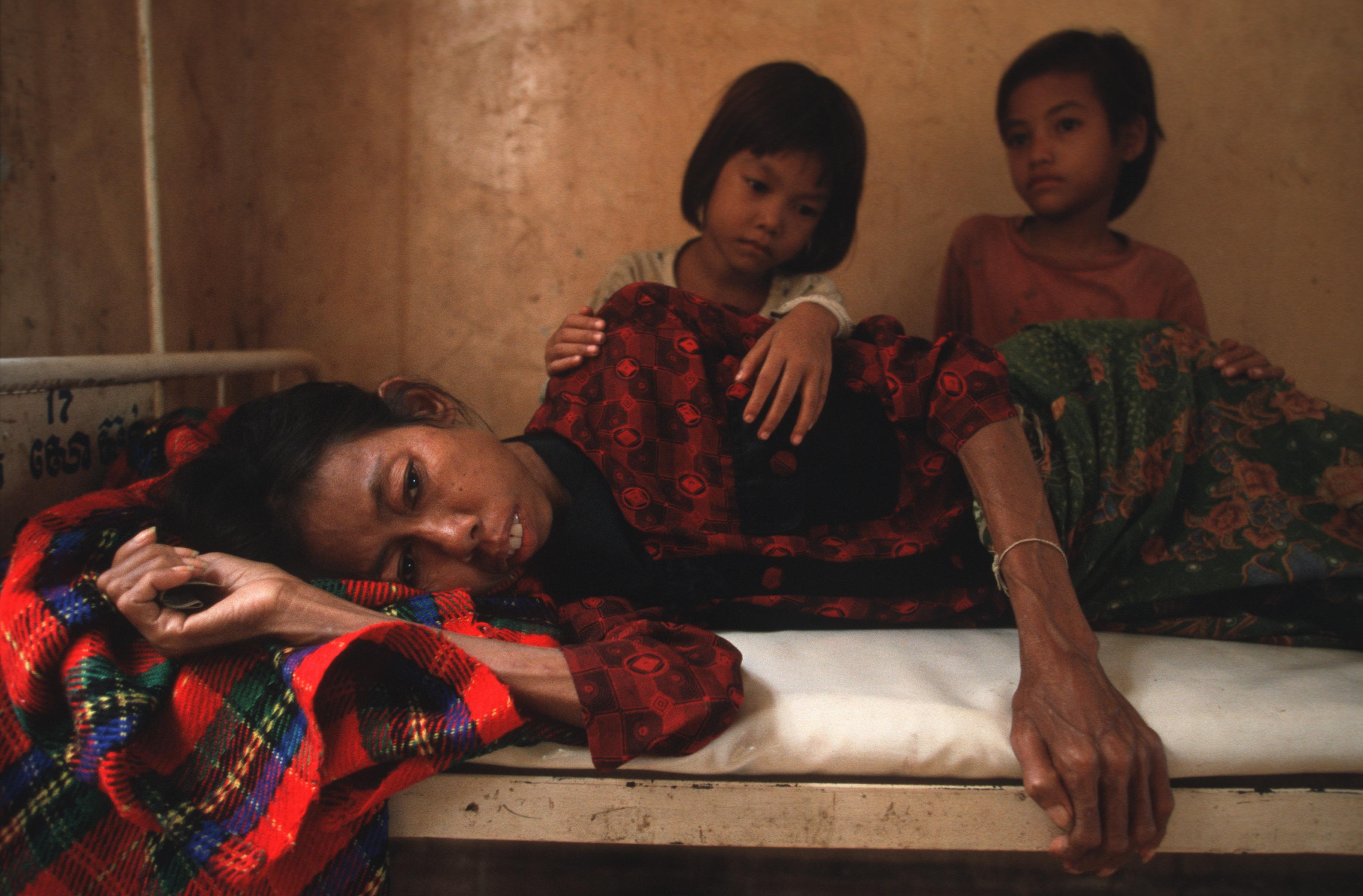
កុមារីពីរនាក់កំពុងសម្លឹងមើលម្តាយរបស់ពួកគេដែលហៀបនឹងដល់សេចក្តីស្លាប់ដោយសារតែជំងឺអេដស៍, ប្រទេសកម្ពុជា។ រូបថត ដោយធនាគារពិភពលោក ថតនៅឆ្នាំ ២០០២។ ក្រោមអាជ្ញារប័ណ្ណ CC BY-NC-ND 2.0។
លក្ខណៈទូទៅពិសេសពីរ ដែលបង្ហាញពីបញ្ហាសុខភាពធំៗដែលគួរឱ្យព្រួយបារម្ភនៅកម្ពុជា៖
- តួលេខសុខភាពមួយចំនួន ដែលស្ថិតក្នុងចំនោមបញ្ហាដ៏អាក្រក់បំផុតនៅក្នុងពិភពលោក - ជាឧទាហរណ៍ ក្នុងឆ្នាំ ២០១៣ ករណីជំងឺគ្រុនផ្តាសាយបក្សីនៅប្រទេសកម្ពុជា មានចំនួន ២៦ ដែលជាចំនួនខ្ពស់បំផុតក្នុងចំនោមបណ្តាប្រទេសដទៃទៀត។1
- វឌ្ឍនភាពគួរអោយចាប់អារម្មណ៍នៅក្នុងផ្នែកមួយចំនួន រួមមាន ជំងឺគ្រុនចាញ់ ជំងឺរបេង និងសុខភាពមាតា។ ប្រទេសកម្ពុជាបានទទួលជោគជ័យនៅក្នុងផ្នែកខ្លះនៃគោលដៅអភិវឌ្ឍន៍សហស្សវត្សរ៍របស់ខ្លួន ហើយនៅក្នុងឆ្នាំ ២០១៥ ប្រទេសនេះត្រូវបានប្រកាសថា លែងមានជំងឺកញ្ជ្រិលទៀតហើយ។
បញ្ហាសុខភាពជាអាទិភាពមានដូចជា៖
- សុខភាពមាតា និងទារក
- ជំងឺរបេង
- ជំងឺគ្រុនចាញ់
- ជំងឺហ៊ីវ/អេដស៍
- ជំងឺផ្តាសាយបក្សី។
ការរីករាលដាលនៃបញ្ហាសុខភាពផ្សេងទៀតរួមមាន កង្វះអាហារូបត្ថម្ភ ជំងឺរាគរូស ការបង្កដោយជំងឺផ្លូវដង្ហើម និងជំងឺគ្រុនឈាម។
សុខភាពមាតា និងទារក
អត្រាមរណភាពមាតា និងទារកនៅកម្ពុជា (ស្ត្រីដែលស្លាប់ដោយសារការជំងឺនានាក្នុងអំឡុងពេលពពោះ ឬក្នុងពេលសម្រាល) មានចំនួនខ្ពស់ដល់ទៅ ១៧០ នាក់ ក្នុងចំនោម ១០០,០០០នាក់ក្នុងរាល់ពេលសម្រាល2 ប៉ុន្តែចំនួននេះបានធ្លាក់ចុះត្រឹម ៨៦ ភាគរយ នៅក្នុងរយៈពេល ១៥ ឆ្នាំ ចុងក្រោយនេះ។3 ការស្លាប់របស់ទារកក៏បានថយចុះផងដែរ ទោះបីជាចំនួនប្រៀបធៀបនៅខ្ពស់នៅឡើយ ហើយអត្រាប្រេវ៉ាឡង់នៃទារកដែលទើបនឹងកើតមិនគ្រប់ទម្ងន់ គឺនៅតែខ្ពស់បើធៀបទៅនឹងប្រទេសដទៃទៀត។
ភាពល្អប្រសើរដែលគួរឱ្យកត់សម្គាល់រួមមាន៖
- ស្ត្រីដែលមានផ្ទៃពោះ ៨៩ ភាគរយ នៅក្នុងឆ្នាំ ២០១៤ បានសម្រាលបុត្រជាមួយពេទ្យឯកទេស ដែលចំនួននេះកើនពី ៧១ ភាគរយ នៅឆ្នាំ ២០១០។4
- ទារក ៨៣ ភាគរយ ត្រូវបានកើតនៅមណ្ឌលសុខភាពនៅក្នុងឆ្នាំ ២០១៤ ដែលចំនួននេះកើនពី ៥៤ ភាគរយ នៅឆ្នាំ ២០១០។5
- ស្ត្រីដែលមានផ្ទៃពោះ ៨១.២ ភាគរយ បានទទួលការថែទាំផ្ទៃពោះមុនសម្រាល6
- ស្តី្រ ៨៤ ភាគរយ បានទទួលថ្នាំគ្រាប់ជាតិដែក និងវីតាមីនបេ។7
- ស្ត្រីមានផ្ទៃពោះ ៧៨ ភាគរយ ដែលមានផ្ទុកមេរោគអេដស៍ បានទទួលការផ្តល់ថ្នាំប្រឆាំងសម្រាប់ការពារការចម្លងវីរុសពីម្តាយទៅកូន។8
ប្រទេសកម្ពុជាមានអត្រាប្រេវ៉ាឡង់នៃទារកដែលទើបនឹងកើតមិនគ្រប់ទម្ងន់ខ្ពស់បំផុតក្នុងចំនោមប្រទេសប្រមាណ ៣០ ដែលត្រូវបានសិក្សានៅក្នុងរបាយការណ៍មួយក្នុងឆ្នាំ ២០១៤។9 ប្រហែល ១៩ ភាគរយនៃកំណត់ត្រាការសម្រាលនៅមន្ទីរពេទ្យ គឺជាទារកតូចមិនគ្រប់គីឡូ (អាស្រ័យចំនួនសប្តាហ៍ដែលពួកគេនៅក្នុងផ្ទៃ)។ ទារកសម្រាលមុនពេលកំណត់ ឬទារកកើតមិនគ្រប់ទម្ងន់មានទំនាក់ទំនងជាមួយនឹងជំងឺដង្កាត់នានាដូចជា ជំងឺត្រៀមព្រាយក្រឡាភ្លើងជាដើម។10
នៅចន្លោះឆ្នាំ ២០០០ និង ២០១០ អត្រាមរណភាពទារក (កុមារដែលមានអាយុក្រោមមួយឆ្នាំ) បានធ្លាក់ចុះពី ៩៥ មកត្រឹម ៤៥ ក្នុងចំនោមទារកដែលកើតចំនួន ១,០០០ នាក់។11
ជំងឺរបេង
ប្រជាជនកម្ពុជាប្រមាណ ១៣,០០០ នាក់ ស្លាប់ដោយសារជំងឺរបេងជារៀងរាល់ឆ្នាំ។12 ប្រទេសនេះហាក់មានការថយចុះនៃការឆ្លងជំងឺរបេងយ៉ាងសន្សឹមៗ។ យ៉ាងណាមិញ នៅក្នុងឆ្នាំ ២០១៣ មានករណីឆ្លងចំនួន ៧៦៤ ក្នុងចំនោមមនុស្ស ១០០,០០០ នាក់ បើធៀបនឹងឆ្នាំ ១៩៩៥ មានចំនួន ១,៦៧០ ករណីក្នុងចំនោម ១០០,០០០ នាក់។13
អង្គការសុខភាពពិភពលោក (WHO) ប៉ាន់ប្រមាណថា ជិត ៦៤ ភាគរយនៃចំនួនប្រជាជនសរុប ឬប្រហែលជាង ៩.៥ លាននាក់ មានផ្ទុកបាក់តេរីជំងឺរបេង។ ពួកគេទាំងនេះ នៅមិនទាន់ឈឺនៅឡើយទេ ហើយក៏មិនអាចចម្លងជំងឺនេះបានដែរ។ មួយក្នុងចំនោម ១០ករណីនៃអ្នកផ្ទុកជំងឺរបេងប៉ុណ្ណោះ ដែលត្រូវបានរំពឹងថានឹងក្លាយទៅជាអ្នកចម្លងជំងឺសកម្ម ប៉ុន្តែតួលេខនេះ គឺខ្ពស់ជាងសម្រាប់ករណីអ្នកមានជំងឺអេដស៍, កង្វះអាហារូបត្ថម្ភ ឬជំងឺទឹកនោមផ្អែម ឬអ្នកជក់បារី។ ២/៣ នៃអ្នកកើតជំងឺរបេងនឹងប្រឈមនឹងការស្លាប់ ប្រសិនបើគ្មានការព្យាបាល។14
ជំងឺគ្រុនចាញ់
ប្រទេសកម្ពុជាបានអះអាងថា ជំងឺគ្រុនចាញ់មានចំនួន ២១,៣០៩ ករណី ហើយចំនួនអ្នកស្លាប់មាន ១២ នាក់នៅក្នុងឆ្នាំ ២០១៣។15 ផលធៀបករណីលើ ១,០០០ បានធ្លាក់ចុះយ៉ាងខ្លាំងចាប់ពីឆ្នាំ ២០០០ ខណៈចំនួននៃការស្លាប់បានថយចុះយ៉ាងគំហុក ពីជាង ៥០០ នាក់ក្នុងឆ្នាំ ២០០០ មកត្រឹម ១២ នាក់ក្នុងឆ្នាំ ២០១៣ ហើយចំនួននេះនៅដដែលនៅក្នុងឆ្នាំ ២០១៤។16
មួយផ្នែកធំនៃភាពជោគជ័យនេះ គឺដោយសារតែភាគច្រើននៃគ្រួសារដែលងាយរងគ្រោះ ត្រូវបានផ្តល់ជូននូវមុងជ្រលក់ថ្នាំ។
ជាអកុសល សម្ពាធថ្មីមួយនៃជំងឺគ្រុនចាញ់នោះគឺ ភាពស៊ាំដោយសារការប្រើប្រាស់ថ្មាំផ្សំ ដែលកំពុងតែមានគំរាមកំហែងកើនឡើង។
ជំងឺហ៊ីវ/អេដស៍
កម្មវិធីស្តីពីជំងឺហ៊ីវ/អេដស៍របស់អង្គការសហប្រជាជាតិ (UNAIDS) ប៉ាន់ប្រមាណថា នៅក្នុងឆ្នាំ ២០១៣ ប្រជាជនប្រមាណ ៧៥,០០០ នាក់នៅក្នុងប្រទេសកម្ពុជា នឹងរស់នៅជាមួយជំងឺហ៊ីវ ដែល ៧០,០០០ នាក់ក្នុងចំនោមពួកគេ មានអាយុពី ១៥ឆ្នាំឡើងទៅ ហើយ ៣៩,០០០ នាក់ក្នុងចំនោមពួកគេ គឺជាស្ត្រី។17 អត្រាប្រេវ៉ាឡង់នៃជំងឺអេដស៍នៅក្នុងចំនោមប្រជាជនមានអាយុចន្លោះពី ១៥ ទៅ ៤៩ ឆ្នាំ បានធ្លាក់ចុះពីចំនួនខ្ពស់ ២.៤ ភាគរយ នៅក្នុងឆ្នា ១៩៩៨ មកត្រឹមចំនួនដែលបានប៉ាន់ស្មាន ០.៧៤ ភាគរយនៅក្នុងឆ្នាំ ២០១៣។18
ចំនួនអ្នកស្លាប់នៃជំងឺហ៊ីវ/អេដស៍ បានធ្លាក់ចុះពីចំនួនប៉ាន់ប្រមាណ ១៤,០០០ នាក់នៅក្នុងឆ្នាំ ១៩៩៩19 មកត្រឹម ២,២០០ នៅក្នុងឆ្នាំ ២០១៣20 ហើយការចម្លងថ្មី បានធ្លាក់ចុះពី ៣,៥០០នាក់ នៅក្នុងឆ្នាំ ២០០៥ មក ១,៣០០ នាក់នៅក្នុងឆ្នាំ ២០១៣។21 នៅក្នុងឆ្នាំ ២០១២ ការចម្លងថ្មី ៥០ ភាគរយ(៦៧៨ នាក់) ត្រូវបានចម្លងរវាងភេទផ្ទុយគ្នា, ២៩ ភាគរយ(៣៩៤នាក់) ចម្លងពីស្ត្រីបម្រើសេវាផ្លូវភេទ, ១០ ភាគរយ (១៣៦ នាក់) ចម្លងពីម្តាយទៅកូន, ៩ ភាគរយ (១២៥ នាក់) ក្រុមអ្នកចាក់បញ្ជូលថ្នាំញៀន និង ១ ភាគរយ (១៥ នាក់) ដោយការរួមភេទរវាងបុរស និងបុរស។22
ចំនួនស្ត្រីបានកើនឡើងជាងពាក់កណ្តាលនៃចំនួនអ្នកដែលមានជំងឺហ៊ីវសរុប ហើយរាប់បញ្ជូលទាំងអ្នកដែលទើបនឹងឆ្លងជំងឺហ៊ីវជាច្រើនទៀត។23
ប្រជាជនប្រមាណ ២៤០ នាក់នៅក្នុងភូមិរកា ស្រុកសង្កែ ខេត្តបាត់ដំបង បានឆ្លងជំងឺហ៊ីវនៅក្នុងឆ្នាំ ២០១៤ បន្ទាប់ពីគ្រូពេទ្យដែលគ្មានអាជ្ញាប័ណ្ណម្នាក់បានប្រើប្រាស់ម្ជុលចាក់ថ្នាំដែលប្រើរួច។24
ជំងឺគ្រុនផ្តាសាយបក្សី
វីរុសផ្តាសាយបក្សី ត្រូវបានរកឃើញនៅនៅក្នុងបសុបក្សីក្នុងប្រទេសកម្ពុជានៅក្នុងខែ មករា ឆ្នាំ ២០០៤ និងត្រូវបានរកឃើញនៅក្នុងខ្លួនមនុស្សនៅក្នុងខែ មករា ឆ្នាំ២០០៥។25 ចាប់តាំងពីពេលនោះមក ប្រទេសនេះបានរាយការណ៍ថា មានករណីមនុស្ស ៥៦ នាក់មានវីរុសនេះ ៤៤ នាក់ក្នុងចំនោមពួកគេមានអាយុក្រោម ១៤ឆ្នាំ ហើយ ៣៧ នាក់ទៀតបានស្លាប់។26, 27
នៅក្នុងឆ្នាំ ២០១៣ មនុស្ស ២៦ នាក់ត្រូវបានអះអាងថាបានឆ្លងវីរុសនេះ ដែលនេះជាចំនួនខ្ពស់បំផុតសម្រាប់ប្រទេសមួយចំនួន។ មនុស្ស ១២ នាក់បានស្លាប់។28 ការរីករាលដាលនៃជំងឺនេះនៅកម្ពុជាត្រូវបានរាយការណ៍ចុងក្រោយបង្អស់ គឺនៅក្នុងខែ មីនា ឆ្នាំ ២០១៤។29
ជំងឺគ្រុនផ្តាសាយបក្សីមានចំនួន ១៦ ប្រភេទផ្សេងគ្នា ដូចជា H5N1 ជាដើម។ សម្ពាធថ្មីនេះ អាចនឹងជះឥទ្ធិពលដល់មនុស្សជាច្រើន។ អង្គការស្បៀងអាហាររ និងកសិកម្ម (FAO) ជឿជាក់ថា វីរុស H5N1 គឺត្រូវបានឆ្លងដល់បសុបក្សីកម្ពុជា។30
បញ្ហាប្រឈមសុខភាពផ្សេងទៀត
បញ្ហានានាដែលកំពុងប្រឈមនៅកម្ពុជារួមមាន៖
- កង្វះអាហារូបត្ថម្ភ - កុមារកម្ពុជា ១ ភាគ ៣ ក្រោមអាយុ ៥ ឆ្នាំ ទទួលរងការលូតលាស់តិចតួចដោយសារតែកង្វះអាហារឧបត្ថម្ភ បើទោះជាចំនួននេះបានធ្លាក់ចុះពី ៤០ ភាគរយ នៅក្នុងឆ្នាំ ២០១០ ក៏ដោយ។ របាយការណ៍ឆ្នាំ ២០១៤ មួយ ចេញដោយទិនានុប្បវត្តិអាស៊ីប៉ាស៊ីហ្វិកនៃគ្លីនិកអាហារូបត្ថម្ភ (Asia Pacific Journal of Clinical Nutrition) បានថ្លែងថា កង្វះអាហារូបត្ថម្ភធ្វើអោយប្រទេសកម្ពុជា ចំនាយច្រើនជាង ៤០០ លានដុល្លារជារៀងរាល់ឆ្នាំ និងបណ្តាលអោយមានការបាត់បង់ជីវិតកុមារ ៦,០០០ នាក់ ក្នុងមួយឆ្នាំៗ។31
- ជំងឺរាគរូស - អង្គការ UNICEF និយាយថា កុមារកម្ពុជា ២,០០០ នាក់ បាត់បង់ជីវិតជារៀងរាល់ឆ្នាំ ដោយសារតែជំងឺរាគរូសដែលអាចបង្ការបាន។32
- ការឆ្លងមេរោគផ្លូវដង្ហើមស្រួចស្រាវ - ជំងឺរលាកទងសួត គឺជាមូលហេតុដ៏ខ្លាំងទី៣ ដែលបណ្តាលឲ្យមានការបាត់បង់ជីវិតកុមារក្រោមអាយុ ៥ ឆ្នាំ។33
- ជំងឺគ្រុនឈាម - មាន ៥០២ ករណីនៃជំងឺគ្រុនឈាម នៅក្នុងរយៈពេល ១៦ សប្តាហ៍ដំបូងនៃឆ្នាំ ២០១៥ ដែលស្មើនឹងកំណើន ៦៧ ភាគរយក្នុងរយៈពេលដូចគ្នាក្នុងឆ្នាំ ២០១៤។34
ធ្វើបច្ចុប្បន្នភាពចុងក្រោយ៖ ២៣ ឧសភា ២០១៥
ទាក់ទងនឹងបញ្ហាសុខភាពជាអាទិភាព
- ការអភិវឌ្ឍសង្គម
- សេវាសុខភាព និងមណ្ឌលសុខភាព
- ជំនួយអភិវឌ្ឍន៍សម្រាប់វិស័យសុខាភិបាល
- គោលនយោបាយ និងការគ្រប់គ្រងវិស័យសុខាភិបាល
ឯកសារយោង
- 1. Denise Hruby, “ការផ្លាស់ប្តូរថ្មីនៃវីរុសផ្តាសាយបក្សីនៅប្រទេសកម្ពុជា”។ កាសែតដឹខេមបូឌាដេលី, ចុះថ្ងៃទី ២៦ ខែ មីនា ឆ្នាំ ២០១៤។https://www.cambodiadaily.com/archives/new-mutation-in-bird-flu-virus-in-cambodia-54896/
- 2. UNICEF. “អត្រាមរណភាពមាតាបានធ្លាក់ចុះស្ទើរតែពាក់កណ្តាល ចន្លោះឆ្នាំ ១៩៩០ និង ២០១៥”។ បច្ចុប្បន្នភាព ខែមេសា ឆ្នាំ២០១៦។ http://data.unicef.org/maternal-health/maternal-mortality
- 3. ដូចឯកសារយោងខាងដើម។
- 4. សែន ដាវីត និង Sarah Taguiam. “ការជម្រុញថ្មីសម្រាប់សុខភាពមាតា”។ កាសែតដឹភ្នំពេញប៉ុស្តិ៍, ចុះថ្ងៃទី ២៣ ខែ កុម្ភៈ ឆ្នាំ ២០១៥។ http://www.phnompenhpost.com/new-push-maternal-health
- 5. ដូចឯកសារយោងខាងដើម។
- 6. ផែនការយុទ្ធសាស្ត្រអភិវឌ្ឍន៍ជាតិ ២០១៤-២០១៨, រាជរដ្ឋាភិបាលនៃព្រះរាជាណាចក្រកម្ពុជា។
- 7. ដូចឯកសារយោងខាងដើម។
- 8. ដូចឯកសារយោងខាងដើម។
- 9. Laignee Barron. “ទម្ងន់ទារកដែលទើបនឹងកើតស្ថិតនៅក្នុងកម្រិតប្រៀបធៀបទាប”។ កាសែតដឹភ្នំពេញប៉ុស្តិ៍, ចុះថ្ងៃទី ២០ ខែ តុលា ឆ្នាំ ២០១៤។ http://www.phnompenhpost.com/national/newborns-weigh-comparably-low-levels
- 10. ដូចឯកសារយោងខាងដើម។
- 11. UNICEF. “សុខភាពកុមារ មាតា និងទារក និងអាហារូបត្ថម្ភ”។ បច្ចុប្បន្នភាព ខែមេសា ឆ្នាំ២០១៦។ http://www.unicef.org/cambodia/6.Maternal.pdf
- 12. USAID, “ជំងឺរបេង និងគ្រុនចាញ់”។ ចូលអានថ្ងៃទី ២១ ខែ ឧសភា ឆ្នាំ ២០១៥។ https://www.usaid.gov/cambodia/tuberculosis-and-malaria
- 13. Maria Wirth និង សែន ដាវីត. “ករណីជំងឺរបេងបានថយចុះប្រមាណ ៣៥ ភាគរយ”។ កាសែតដឹភ្នំពេញប៉ុស្តិ៍, ចុះថ្ងៃទី ២៤ ខែ មីនា ឆ្នាំ ២០១៤។ http://www.phnompenhpost.com/national/about-35-tb-cases-%E2%80%98missed%E2%80%99
- 14. ដូចឯកសារយោងខាងដើម។
- 15. WHO. ទិន្នន័យព័ត៌មានតាមប្រទេស. “ការស្លាប់ និងផលប៉ះពាល់នៃជំងឺ”។ ចូលអានថ្ងៃទី ២១ ខែ ឧសភា ឆ្នាំ ២០១៥។ http://www.who.int/malaria/publications/country-profiles/profile_khm_en.pdf?ua=1
- 16. ហ៊្សូមបឺ ផីតធឺរ. “របាយការណ៍រដ្ឋាភិបាលមិនមានការកើនឡើងប្រឆាំងនឹងការស្លាប់ដោយសារជំងឺគ្រុនចាញ់”។ កាសែតដឹខេមបូឌាដេលី, ចុះថ្ងៃទី ២៩ ខែ មករា ឆ្នាំ២០១៥។ https://www.cambodiadaily.com/archives/govt-reports-no-gains-against-malaria-deaths-76909/
- 17. UNAIDS. “ការប៉ាន់ប្រមាណនៃជំងឺ HIV និងអេដស៍ (២០១៥)”។ ចូលអានថ្ងៃទី ២១ ខែ ឧសភា ឆ្នាំ ២០១៥។ http://www.unaids.org/en/regionscountries/countries/cambodia
- 18. KHANA. “ជំងឺអេដស៍នៅប្រទេសកម្ពុជា”។ ចូលអាននៅថ្ងៃទី ២១ ខែ ឧសភា ឆ្នាំ ២០១៥។ https://khana.org.kh/health-information-about-hiv/
- 19. Index mundi. “ប្រជាសាស្ត្រ៖ ការស្លាប់នៃជំងឺ HIV/អេដស៍”។ ចូលអានថ្ងៃទី ២១ ខែ ឧសភា ឆ្នាំ ២០១៥។ http://www.indexmundi.com/g/g.aspx?c=cb&v=37
- 20. KHANA. “ជំងឺអេដស៍នៅប្រទេសកម្ពុជា”។ https://khana.org.kh/health-information-about-hiv/
- 21. ដូចឯកសារយោងខាងដើម។
- 22. ឆេក. “ជំងឺ HIV/អេដស៍នៅក្នុងប្រទេសកម្ពុជា”។ ចូលអានថ្ងៃទី ២១ ខែ ឧសភា ឆ្នាំ ២០១៥។ http://www.checcambodia.org/
- 23. ដូចឯកសារយោងខាងដើម។
- 24. គណៈកម្មការសម្របសម្រួលប្រយុទ្ធនឹងជំងឺអេដស៍, “ស្ថានភាពប្រជាជនរស់នៅជាមួយវីវុសហ៊ីវ និងជំងឺអេដស៍នៅក្នុងឃុំរកា ស្រុកសង្កែ ខេត្តបាត់ដំបង”។ ចូលអានថ្ងៃទី ២១ ខែ ឧសភា ឆ្នាំ ២០១៥។ http://www.hacccambodia.org/view_news.php?id=574
- 25. Nature. “WEB Focus – បន្ទាត់ពេលវេលានៃជំងឺផ្តាសាយបក្សី”. http://www.nature.com/nature/focus/avianflu/timeline.html
- 26. ‘នាយករដ្ឋមន្ត្រី៖ ប្រទេសកម្ពុជាត្រូវការសកម្មភាពបន្ថែមដើម្បីព្យាបាលជំងឺគ្រុនផ្តាសាយបក្សី’, សារព័ត៌មានស៊ិនហ័រ, ចុះថ្ងៃទី ២៩ ខែ មីនា ឆ្នាំ ២០១៤។ ចូលអានថ្ងៃទី ២៣ ខែ ឧសភា ឆ្នាំ ២០១៥។ http://www.shanghaidaily.com/article/article_xinhua.aspx?id=209230
- 27. Robert Carmichael. ‘ការដោះស្រាយជាមួយជំងឺគ្រុនផ្តាសាយបក្សី, ប្រជាជនកម្ពុជាជាច្រើនរងចាំសម្រាប់សំណង’។ សារព័ត៌មាន Deutche Welle, ចុះថ្ងៃទី ២៨ ខែ មិនា ឆ្នាំ ២០១៤។ http://www.dw.com/en/grappling-with-avian-flu-cambodians-wait-for-compensation/a-17528155
- 28. Denise Hruby. “ការផ្លាស់ប្តូរថ្មីនៃវីរុសផ្តាសាយបក្សីនៅប្រទេសកម្ពុជា”។ កាសែតដឹខេមបូឌាដេលី, ចុះថ្ងៃទី ២៦ ខែ មីនា ឆ្នាំ ២០១៤។ https://www.cambodiadaily.com/archives/new-mutation-in-bird-flu-virus-in-cambodia-54896/
- 29. The Poultry Site. “ព័ត៌មានថ្មីៗអំពីផ្តាសាយបក្សី”។ ចូលអានថ្ងៃទី ២៣ ខែ ឧសភា ឆ្នាំ ២០១៥។ https://thepoultrysite.com/bird-flu/bird-flu-news.php?country=kh
- 30. Robert Carmichael. “កិច្ចខិតខំប្រឹងប្រែងអន្តរជាតិកំពុងដំណើរការដើម្បីគ្រប់គ្រងផ្តាសាយបក្សីនៅក្នុងប្រទេសកម្ពុជា.”។ វីអូអេ, ចុះថ្ងៃទី ២១ ខែ មិនា ឆ្នាំ ២០១៤។ http://www.voanews.com/a/international-efforts-underway-to-control-bird-flu-in-cambodia/1876060.html
- 31. ប៉ិច សុធារី. “អង្គការសហប្រជាជាតិ៖ ការកង្វះអាហារូបត្ថម្ភនៅតែកើតមាន.” កាសែតដឹភ្នំពេញប៉ុស្តិ៍, ចុះថ្ងៃទី ២៧ ខែ មិនា ឆ្នាំ ២០១៥។ http://www.phnompenhpost.com/national/malnutrition-still-endemic-un
- 32. Laignee Barron. ‘‘របាយការណ៍៖ ទឹកស្អាតនឹងអាចឱ្យកុមារបន្តទៅសាលារៀន’’។ កាសែតដឹភ្នំពេញប៉ុស្តិ៍, ចុះថ្ងៃទី ១៧ ខែ មិនា ឆ្នាំ ២០១៤។http://www.phnompenhpost.com/national/clean-water-keeping-kids-school-report
- 33. Ly, N., Email, R. T., Mishra, N., Sameroff, S., Jain,, K., Rachmat,, A., . . . Lipkin, W. I. (ចេញផ្សាយថ្ងៃទី ១៧ ខែ ធ្នូ ឆ្នាំ ២០១៤). ការវិភាគពហុគុណ PCR នៃចង្កោមនានានៃការឆ្លងមេរោគរលាកផ្លូវដង្ហើមមិនអាចពន្យល់បាននៅក្នុងប្រទេសកម្ពុជា។ Virology Journal 11:224. DOI: 10.1186/s12985-014-0224-x។ http://virologyj.biomedcentral.com/articles/10.1186/s12985-014-0224-x
- 34. Sean Teehan និងតាំង វីដា. ‘‘រដ្ឋាភិបាល៖ ការសិក្សាពីជំងឺគ្រុនឈាម’’។ កាសែតភ្នំពេញប៉ុស្តិ៍, ចុះថ្ងៃទី ១១ ខែ ឧសភា ឆ្នាំ ២០១៥។http://www.phnompenhpost.com/national/dengue-cases-govt

